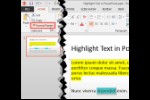Learn about using fonts in PowerPoint. We cover font embedding, converting fonts to vectors, font smoothing, and replacing fonts.
Author: Geetesh Bajaj
Product/Version: PowerPoint
The Basics
The Rules of Fonts
Font Embedding
Convert Type to Vectors
Font Smoothing
Replace Fonts
Dingbat Bullets
Many Fonts Can Crash...
A font or typestyle can cause an impact, set a mood, and extend a character of a presentation.
It's important to be aware of the basic text possibilities in PowerPoint before formatting your fonts. Read more about that in Indezine's PowerPoint and Text page.
Freedom without constraints is an important consideration. At times, rules can hamper creativity and prevent brilliant ideas. So, the first rule of fonts is ironically to break all rules.
The second rule is to realize that if your broken rules sever a visual balance, then, be generous enough to admit your mistake and stick to the written rules of typography.
Let's look at other rules now.
PowerPoint allows you to embed a copy of a font used in a presentation within its format. But that's not the end of the story. Things are not quite that simple. Anyway, let's find out how to embed fonts before discussing its aspects.
This can be achieved by the File | Save As option, and then checking the Embed True Type Fonts box. If a font cannot be embedded, PowerPoint will inform you accordingly.
Not all TrueType fonts can be embedded, and Type 1 or PostScript fonts cannot be embedded at all. If you don't know the difference between Type 1, TrueType, or OpenType fonts, look at our Identify Font Types in Windows page.
To find out if a particular font is embeddable, you can get a free extension from the Microsoft Typography site. It's called the Font Properties Extension and once it has been installed, you can right-click any font in your Windows Fonts folder (normally C:\Windows\Fonts, but your path may differ) and select Properties (this only works in older versions of Windows). The resultant properties box is full of tabs which provide all kinds of information about the font in question. This includes one tab with its embedding rights.
Microsoft also provides a Font Properties Editor at its site. Although this tool allows you to make a font's embedding rights more restrictive, it doesn't allow you to allot embedding rights to an already restricted font.
If you create your own fonts using Macromedia Fontographer, you will find a Technical note at the Macromedia site which speaks about editing font properties.
Quite often, you are faced with a situation where a font does not allow embedding. Alternatively, you've used a few characters of a font in question, and embedding the font balloons up the presentation file size beyond expected proportions.
In that case, you can typeset the particular font in a vector graphics program like CorelDRAW, Adobe Illustrator, Macromedia Freehand/Flash, Deneba Canvas or Xara X. The text could be exported to a capable vector format like EMF or WMF. This could be then imported as a graphic in PowerPoint, which would automatically be embedded within a presentation. Do note that newer versions of PowerPoint allow you to convert text to shapes within PowerPoint itself.
Such a graphic can be animated like any other PowerPoint object. In fact, it can even ungrouped, re-colored and edited within the confines of the PowerPoint interface.
Font Smoothing is a feature which Microsoft released initially in the Windows 95 Plus Pack. The feature was incorporated in the main operating system in later versions of Windows.
The Font Smoother is available as a free download from the Microsoft site.
The article, Smooth Fonts at the Microsoft Typography site explains the entire concept.
Sometimes you are faced with a peculiar situation. You've used a particular font nowhere in the presentation and on saving the presentation, PowerPoint brings forth a warning which in effects says that this font cannot be embedded!
In such a situation, go to Format | Replace Fonts and select the offending font in the Replace drop down list. In the With drop down list, select a safe font you've used elsewhere in a presentation.
You've got too many fonts installed, and certain components of PowerPoint like the Organization Chart are giving you nightmares. This particular program crashes every time you use it!
The solution is simple. Reduce the number of fonts installed to a more manageable level.
You May Also Like: Presentation Management is Risk Management | Fine Arts PowerPoint Templates




Microsoft and the Office logo are trademarks or registered trademarks of Microsoft Corporation in the United States and/or other countries.